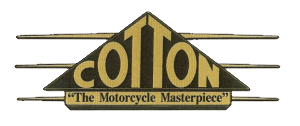


The 1920 Olympia Show.
Cotton. (Stand 165.)
2½ h.p. Villiers; 70x70 mm. (269 c.c); single-cylinder two-stroke; drip-feed lubrication; Amac carburetter; flywheel magneto; two-speed Albion gear; chain and belt drive; Dunlop 26x2¼ in. tyres. Price £71 8s.
The Cotton Motor Co. Bristol Road, Gloucester.
Triangulated frame construction has been for years the text of the theorist, but in practice pedal cycle ideas and fashions remain very much with us. Eminently satisfactory as the conventional frame proves, it should not be regarded for this reason as le dernier cr; and an advanced design, such as the Cotton, which breaks away entirely from convention, deserves every encouragement, for in that direction progress lies. Rigidity combines with lightness in the Cotton duplex triangulated frame, while a long, straight sweep from steering head to rear axle permits the rider's centre of gravity to lie well forward and low. As a consequence, it should give a sense of security and a very tangible absence of "skid" on grease. In this case an unconventional appearance does not mean a displeasing appearance. In fact, there is something extremely taking about the lines of the Cotton. It is worthy of note that the makers recommend disc wheels. Owing to its construction the machine is particularly suited for the lady motor cyclist, for whom it may be fitted with a kick-starter and dressguards. Wider mudguards and a larger tank are 1921 improvements, but otherwise the design is basically unaltered.
Olympia Show, 1920
The Motor Cycle, December 2nd, 1920. Page 700
The 1922 Olympia Show.
COTTON. (Stand 23.)
Successful Frame Triangulation.
2¾ H.P. Model.
71x88 mm. (348 c.c); single cyl. four-stroke; overhead valves; drip feed fabrication; Amac carburetter; chain-driven mag.; 3-sp, gear; clutch, no kick-starter; chain drive; 26x2¼in. tyres. Price, £72.
The Cotton Motor Co., Gloucester.
Until this year the advantages of the Cotton duplex and fully triangulated frame have been admitted mainly in theory. At the T.T. races they were demonstrated in practice. S. Woods, the Cotton rider, came very near to winning the 350 c.c. class, actually finishing fifth after an unparalleled series of accidents, including a fire that put his brakes out of action. A machine on which feats like this have been accomplished naturally demands attention, and considerable interest is being taken in its marketed replica.
The o.h.v. Blackburne engine is sloped forward in the frame, but otherwise the power unit, transmission, etc., are adequately covered by the specification above. A neat cylindrical aluminium silencer is fitted to this and all the Cotton models.
Four other less racy Cottons are on show : (1) a 247 c.c. Villiers with two-speed gear and final belt drive, £49; (2) a 249 c.c. side-valve Blackburne with the same transmission, £57; (3) a 348 c.c. side-valve Blackburne, also with the same transmission, £60; and (4) a 348 c.c. Blackburne with three-speed gear and all-chain drive, £67.
1923 improvements include an alteration to the head lug, which lowers the handlebars by 1½in. The saddle remains about 25in. from the ground.
Olympia Show 1922
The Motor Cycle, November 30th, 1922. Page 854
A report on the Motor Cycle Show of November 1924 in Motor Sport Magazine reads, in part:
The feature of the Cotton motor cycle is the unusual design of the frame, which is a triangulated structure, designed in accordance with knowledge of the mechanical principles. It is claimed that this frame affords greater strength than the standard diamond frame, while being much lighter, that it maintains the wheel alignment definitely, and that it is particularly suitable for ladies' use. The Cotton machine has been very successful in trials, and won the Junior T.T. last year.
For 1925 the chain-cum-belt model has been dropped, and the smallest machine is the 2 1/2 h.p. Blackburne-engined motor cycle, which is equipped with three-speed gear, clutch and kickstarter, and with a final drive by chain. The sports model has a Blackburne sports engine, which is claimed to be capable of very high revolutions, affording a speed of from 70 to 75 m.p.h. The engines of these sports models are forwardly inclined, thus affording a lower centre of gravity and improving stability at corners.
Examples of all models are on view on the stand, and it will be noted, in comparing these with last year's models, that heavier type mudguards are fitted with magneto shields and silencers on the O.H.V. models, while what is not apparent to the observer is the heavier gauge material used for the tank."
The Cotton Motor Company, Gloucester.
The Cotton for 1928 is far in advance of last year's machine. There are some very attractive speed models with J.A.P. or Blackburne o.h.v. engines, either single or double port. Handsome saddle tanks are fitted to the sports models, and the frame has been shortened and constructed of heavier tubing. The magneto mounting is particularly worthy of praise, being in a very accessible place high up behind the engine. Altogether the Cotton is a machine which will make an instant appeal to the sportsman, who knows the wonderful road holding qualities of the triangulated frame.
If you have a query or information about Cotton motorcycles please contact us